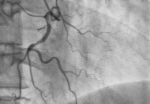Successful chronic total occlusion procedures are on the rise, especially in high volume centers, seeing as they count on more sophisticated materials and different techniques, such the retrograde approach. However, the significant increase of success rate with this technique has also brought along an increase in associated complications. The aim of this study was to...
Clinical Results of IVUS-Guided Drug-Eluting Stent Implantation in Femoropopliteal Disease
Endovascular treatment of femoropopliteal lesions has become the first-line treatment due to the development of devices that decrease the restenosis rate. Recently, the IMPERIAL study showed greater patency at 1 year and greater freedom from clinically guided revascularization at 2 years in favor of the ELUVIA stent (paclitaxel-eluting fluoropolymer, FP-DES) compared with the ZILVER PTX...
The Best of the SOLACI-SOCIME 2022 Main Arena: Complex PCI Guided by Intravascular Imaging
In the first session of SOLACI-SOCIME 2022 on “Complex angioplasty guided by intravascular imaging”, Dr. Alejandro Diaz (MEX) reviewed the evidence on intravascular ultrasound (IVUS) in complex angioplasties. A meta-analysis indicated its use is associated with a significant decrease in the risk of death, acute myocardial infarction (AMI), and new target lesion revascularization (TLR) in...
CTO: Trials vs. Real-World
Percutaneous coronary intervention of chronic total occlusions (CTO) is currently indicated for symptom improvement, as studies have inadequate randomization of data which hinders the assessment of hard outcomes. However, patient inclusion in randomized controlled trials has been challenging, especially for highly symptomatic and higher risk patients. This causes a selection bias in randomized studies on...
Progress-CTO Score: A Key New Tool to Plan CTO
Intervention of chronic total occlusions (CTO) through angioplasty (PCI) can cause complications, even in highly experienced centers. Plenty has been written on the probability of success for the treatment of CTOs using scores such as CL-SCORE, J-CTO, ORA, E-CTO, CASTLE-CTO, etc. (some of which are usually used when preparing these cases). However, besides estimating success...
Changes in Coronary Collateral Function Post CTO Intervention
In the last few years, we have seen significant growth of chronic total occlusion (CTO) percutaneous intervention, which has also been considered for patients with viable territory that remain symptomatic. Experienced centers present successful CTO intervention rates close to 90%, especially with a hybrid approach. However, it is still a complex procedure, and target vessel...
Is IVUS Guided PCI a Common Technique?
We all know the benefits of ultravascular ultrasound (IVUS) in the development of percutaneous coronary intervention, such as more accurate vessel measurement, improved stent expansion and apposition, and complication identification. This is why the use of IVUS is a class IIa recommendation in AHA and ESC guidelines. The aim of this retrospective study was to...
DISCO RADIAL: Conventional or Distal Transradial Access?
Conventional transradial access (TRA) is already established as the access of choice for percutaneous coronary procedures, regardless of clinical presentation. This choice is based on multiple randomized studies and meta-analyses that have shown reduced bleeding at the puncture site, less vascular complications, and benefits on mortality (mainly in high-risk patients). The practicality of recovery allows...
EuroPCR 2022 | The IMPROVED-CTO Trial
PCI success rate in chronic total occlusion (CTO), according to some registries, is below 80%. These failed revascularization procedures might lead to quality-of-life deterioration and shorter survival. This concern has driven the development of new techniques and technologies in an attempt to increase PCI success. Today, approximately 20% of CTOs are treated with a second...
Transfemoral vs Transradial Approach in the Percutaneous Treatment of CTO
Percutaneous treatment of chronic total occlusion (CTO) has traditionally been via the transfemoral approach (TFA). The use of the transradial approach (TRA) in complex coronary interventions has been increasing. A randomized study assessed the use of TRA vs TFA in complex PCI (58% CTO) and TRA saw favorable outcomes. The aim of this prospective, randomized,...









